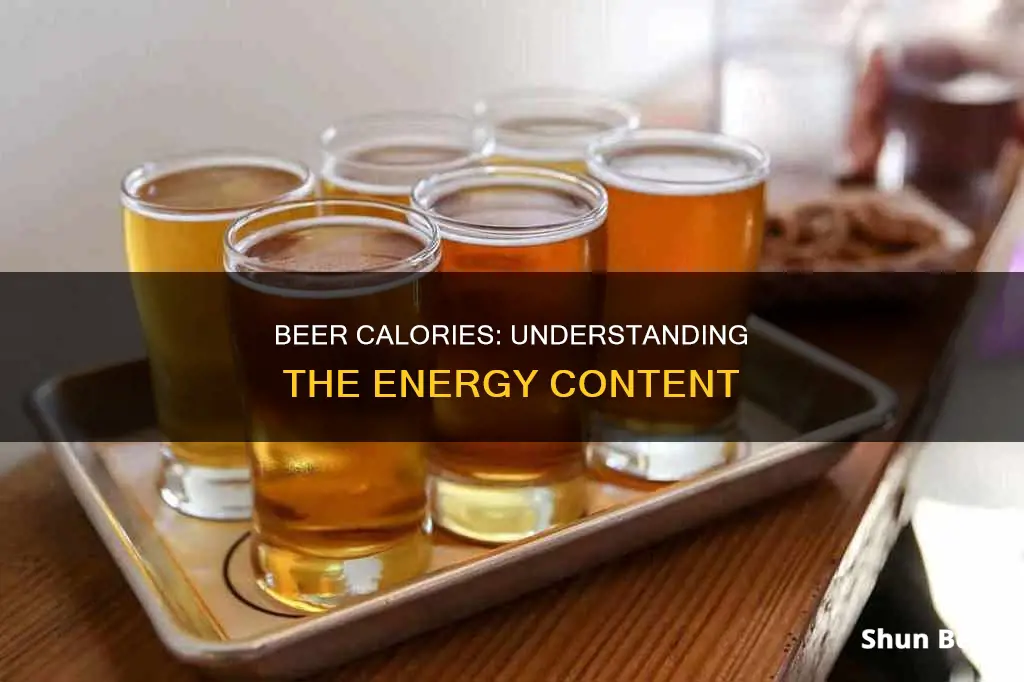
Beer is a popular drink worldwide, but it's also associated with the term 'beer belly'. So, how many calories are in beer, and what factors influence this? Beer is made from fermented grains, and the calories come from alcohol and carbohydrates. The higher the ABV, the more calories in your beer. A lager with 4.5% ABV will have 135 calories, while a 10.5% stout will have 315 calories. Beer is higher in calories than wine or spirits, and it has minimal nutritional value, so it's often referred to as 'empty calories'. However, non-alcoholic beer has some health benefits, and some beers are lower in calories than others. On average, a pint of beer has around 215 calories, but this varies by brand and style.
Characteristics of the Calorie Content in Beer
| Characteristics | Values |
|---|---|
| Calories from | Alcohol and Carbohydrates |
| ABV impact on calories | Higher ABV, more calories |
| Calories per gram of alcohol | 7 calories |
| Beer type impact | Lagers tend to have fewer carbs than ales, which have fewer carbs than stouts |
| Average calories in a pint of beer | 215 calories |
| Average calories in a 12-ounce beer | 150 calories |
| Average calories in a 12-ounce light beer | 100 calories |
What You'll Learn

Beer calories come from alcohol and carbohydrates
Beer is made from fermented grains, such as barley and wheat, which contain carbohydrates. The sugar extracted from these grains is what causes the beer to ferment, and the more sugar present, the more alcohol there will be, and therefore more calories. Beer calories come from alcohol and carbohydrates, with around 60% from alcohol and 40% from carbohydrates.
The number of grains and added sugars that remain in the beer depends on the fermentation process and the ingredients used. For example, a lager with 4.5% ABV at 12 oz will total 135 calories, while 12 oz of a barrel-aged stout at 10.5% will total 315 calories. Beers with a higher alcohol content will generally have more calories than those with lower alcohol content.
Craft, seasonal beers, and beers with high alcohol content tend to have more calories than lighter beers. Beer is typically higher in calories than other beverages, including wine and spirits. Beer is often referred to as "empty calories" because, unlike calories from most foods, the calories in beer don't provide energy for the human bodies.
However, non-alcoholic beer does have some health benefits and usually contains fewer calories. If you are watching your calorie intake, opting for non-alcoholic or light beers can be a good choice. Light beers usually have fewer carbohydrates and more water, resulting in fewer overall calories.
The Quest for Zero-Calorie Beer: Is It Possible?
You may want to see also

Alcohol is highly calorific, with a gram containing seven calories
The calorific content of beer is largely determined by its alcohol and carbohydrate content. The higher the ABV, the more calories a beer will contain. For example, a 12-ounce beer with 4% ABV has about 150 calories, while a 12-ounce beer with 5% ABV has about 150-180 calories.
The type of beer also affects its calorie count. Lagers, for instance, tend to contain fewer calories than ales, which in turn have fewer calories than stouts. However, this is not always the case, as some lagers may contain as many calories as dark beers.
Beer is considered "empty calories" because, unlike calories from most foods, the calories in beer do not provide energy for the human body. Additionally, beer has little nutritional value.
To calculate the number of calories in a beer, you can use the following formula:
Calories = (ABV% x 2.5) x fluid ounces
For example, a 16-ounce beer with 6% ABV has about 240 calories.
Calories in Brookvale Union Ginger Beer: Nutritional Breakdown
You may want to see also

Beer with higher alcohol content will have more calories
It's true that beer with a higher alcohol content will generally contain more calories. This is because around 60% of the calories in beer come from alcohol, with the remaining 40% coming from carbohydrates. The more alcohol there is in a beer, the more calories it will contain.
Calorie Content in Beer
The calorie content of beer can vary widely depending on the alcohol percentage. For example, a 12-ounce beer with 4% ABV has about 150 calories, while a 12-ounce beer with 10.5% ABV can have up to 315 calories. Beers with higher alcohol content, such as Belgian brews, IPAs, and stouts, often contain 7 to 10% alcohol, putting them in the 200- to 300-calorie range.
Calculating Calories in Beer
You can use a simple formula to calculate the approximate number of calories in a beer:
> Calories = ABV% x 2.5 x ounces of beer
For example, a 16-ounce beer with 6% ABV would have approximately 240 calories.
Strategies for Reducing Calorie Intake
If you're concerned about your calorie intake from beer, there are a few strategies you can employ. Firstly, you can opt for low-calorie beers, which typically have a low ABV of 4.5% or less. Non-alcoholic beers also tend to have fewer calories. Additionally, you can try drinking in moderation, choosing lighter or smaller servings, or alternating alcoholic drinks with water or tonic water.
Calories in Beer-Battered Haddock: Nutritional Breakdown
You may want to see also

Beer is higher in calories than wine or spirits
Beer is a popular drink worldwide, but it is important to be aware of its nutritional content, especially if you are watching your weight. Beer is higher in calories than wine or spirits, and it is often referred to as "empty calories" due to its lack of nutritional value.
The calories in beer come primarily from two sources: alcohol and carbohydrates. The higher the alcohol content in a beer, the more calories it will contain. This is because alcohol is highly calorific, with seven calories per gram, almost as much as pure fat. Additionally, the fermentation process of cereals, such as barley and grains, produces sugar, which also contributes to the calorie count.
Compared to other alcoholic beverages, beer tends to have a higher calorie content. For example, a typical 12-ounce beer has around 140 calories, similar to a can of Coke. In contrast, a 6-ounce pour of wine, which is a standard restaurant serving, has about 150 calories. Spirits like gin, rum, tequila, vodka, and whiskey contain approximately 100 to 120 calories per 1.5-ounce shot.
The type of beer also affects its calorie content. Dark beers, for instance, tend to have more carbohydrates and, therefore, more calories than light beers. Lagers generally have fewer calories than ales, and ales have fewer than stouts. However, there are exceptions, as some lagers may have as many calories as dark beers.
Craft beers, seasonal beers, and beers with high alcohol content will usually have more calories than lighter options. If you are watching your calorie intake, opting for alcohol-free or light beers can be a good strategy, as these typically contain fewer calories.
It is worth noting that while beer can be part of a healthy diet when consumed in moderation, excessive drinking can lead to various short-term and long-term health risks. Therefore, it is important to drink in moderation and be mindful of the number of calories in your beverage of choice.
Calories in Labatt Blue Beer: Nutritional Breakdown
You may want to see also

Beer is considered empty calories due to its low nutritional value
Beer is considered to provide "empty calories" due to its low nutritional value. While beer is made from grains, which can be healthy, the calories in beer come primarily from alcohol and carbohydrates. About 60% of beer calories are from alcohol, and the remaining 40% are from carbs.
The exact number of calories and carbohydrates in beer depends on the type of brew and the amount consumed. A typical 12-ounce beer has around 140 calories, which is similar to a can of Coke. Some beers can have twice as many calories. For example, a 12-ounce lager at 4.5% ABV will have 135 calories, while a 12-ounce barrel-aged stout at 10.5% ABV will have 315 calories.
Beer tends to be higher in calories than other beverages, such as wine and spirits. A 12-ounce beer that is 4% ABV has about 150 calories, while a 12-ounce glass of wine is around 150 calories for a 9-ounce pour. Liquor, such as gin, rum, tequila, vodka, or whiskey, typically has 100 to 120 calories per 1.5-ounce shot.
The calories in beer come from the fermentation process, which produces alcohol. Alcohol is highly calorific, with seven calories per gram, almost as much as pure fat. The remaining calories in beer come from residual carbs that were not fully fermented during brewing. Different types of beer contain varying amounts of carbs, with lagers generally containing fewer carbs than ales, and ales containing fewer carbs than stouts.
While beer can be part of a healthy diet when consumed in moderation, it is important to be mindful of the number of calories and the potential impact on weight gain. Drinking lower-alcohol beers, avoiding rounds, and drinking less regularly can help reduce calorie intake from beer.
Calories in Wasatch Beer: Snap Down Pilsner Explained
You may want to see also
Frequently asked questions
The calories in beer come from alcohol and carbohydrates. According to the Homebrewer's Association, about 60% of beer calories come from alcohol, and the remaining 40% come from carbs.
The number of calories in a beer depends on the type of beer and its alcohol content. A typical 12-ounce beer has around 140 calories, which is similar to a can of Coke. Some beers have twice as many calories. An average 5% alcohol beer, like Budweiser, has around 150 calories.
You can use the following formula to calculate the number of calories in a beer:
Calories = (ABV% x 2.5) x fl oz







